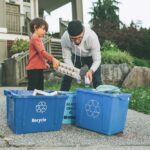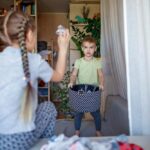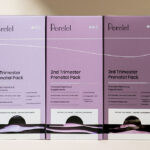A Real-Parent Guide to Eco-Friendly Parenting (That Doesn’t Feel Overwhelming)

Eco-friendly parenting isn’t about perfection—it’s about everyday choices that teach our kids to live with purpose, protect the planet, and build habits that matter for future generations.
Being a parent means constantly juggling nap schedules, snack demands, and the mountain of laundry that never ends. So if the phrase “eco-friendly parenting” makes you want to roll your eyes and reach for a disposable wipe—hang with me.
Going green doesn’t have to mean perfection or a complete lifestyle overhaul. In fact, eco-friendly living with kids is often about making small swaps that actually stick. Think less plastic and more purpose. Less guilt, more good habits. It’s not about being crunchy—it’s about being conscious.
Every time we choose a reusable snack bag instead of a plastic one, or compost apple cores instead of tossing them in the trash, we’re teaching our kids something important: how to care for the planet they’re growing up in.
And spoiler? It’s more doable than you think.
Choosing Green Starts Early: Baby Steps Count
Let’s start at the beginning—literally. From the moment your baby arrives, you’re met with a mountain of decisions, and many of them have eco options that are easy to adopt. One of the most impactful swaps? Cloth diapering. While not every family will go fully cloth, even using reusable diapers part-time can significantly reduce landfill waste.
Consider creating a minimalist baby registry that prioritizes essentials and avoids duplicates. Borrow what you can, share with other parents, and say yes to hand-me-downs. It not only saves money, it keeps perfectly good items in use—supporting a circular parenting cycle that’s both practical and sustainable.
Here are a few more simple ways to practice sustainable parenting right from the start:
- Reuse what’s already out there. Baby swings, strollers, high chairs—gently used gear is everywhere. Accept those hand-me-downs or check local swaps to keep items circulating (and out of landfills).
- Lower your carbon footprint with conscious shipping choices. Opt for local or bulk buys when possible, and try to limit one-off deliveries.
- Choose long-lasting over trendy. Neutral-toned baby clothes, convertible furniture, and adjustable gear that grows with your child are better for the planet (and your wallet).
- DIY when you can. From cloth wipes to homemade baby food, simple swaps help reduce waste and packaging.
- Be intentional about toys. Fewer, better toys made from natural or recycled materials reduce clutter and environmental impact.
Each tiny shift adds up—and while perfection isn’t the goal, progress definitely is. Starting small is still starting strong. And when you build eco habits early, they become second nature for the whole family.
Skip the Landfill: Embrace Second-Hand and Upcycling
Kids grow fast. Clothes, toys, furniture—they all seem to have a three-month lifespan. Instead of buying new every time, lean into second-hand options. Thrift shops, neighborhood swaps, and online parent groups are goldmines for gently used gear.
Got something worn or torn? Upcycling is a fun way to breathe new life into old items. Turn worn-out jeans into art smocks. Use puzzle pieces with missing mates for craft projects. When kids see you repurpose, they learn resourcefulness and creativity.
It’s a small shift with a big impact—and it’s what green parenting is all about.
Here are a few easy ways to start:
- Shop second-hand for baby products like high chairs, bouncers, and clothing (just be sure to double-check safety recalls).
- Host a toy swap with other parents to refresh your stash without spending a dime.
- Repurpose baby wipes containers into crayon boxes, sensory bins, or small toy storage.
- Donate instead of ditching. Outgrown items can find new homes instead of filling landfills.
- Get kids involved. Let them help redesign old clothes or build DIY toys from recycled materials—they’ll feel ownership and pride.
Second-hand doesn’t mean second-best. In fact, embracing reuse is one of the easiest ways to practice sustainable living as a family while modeling mindful habits.
Ditch the Disposables: Simple Swaps for Everyday Living
One of the easiest ways to reduce your environmental impact is to replace single-use plastics with reusable alternatives. Start small: stainless steel water bottles, beeswax wraps instead of plastic wrap, or silicone snack bags instead of sandwich baggies. Even toddlers can help fill their own bottles or pack snacks—bonus points for autonomy.
When possible, choose glass or stainless steel baby bottles, wooden toys over plastic, and bulk purchases that reduce packaging. Every time you avoid a single-use item, you send a message that sustainability matters—even in the little things.
Not sure where to begin? Try a few of these easy conscious choices:
- Swap paper towels for washable cloths or old T-shirts cut into rags.
- Replace disposable baby wipes with reusable cloth wipes (they’re softer, too).
- Choose refillable soap and shampoo containers over single-use bottles.
- Use a drying rack instead of the dryer to save energy—and extend clothing life.
These little switches may seem small now, but they add up—and they teach your child that renewal and reuse are part of everyday life.
Because sustainable parenting isn’t just about now—it’s about building better habits for our future generations.
Create a Low-Waste Kitchen Together
One sneaky source of household waste? The kitchen. Teaching your kids about food waste and simple eco-habits like composting can be surprisingly fun (and a little gross, which they love). A countertop compost bin makes it easy to collect scraps, and a backyard pile or city pickup takes care of the rest.
Help your family embrace a sustainable lifestyle right at the kitchen table:
- Keep reusable snack bags and lunch containers within reach so kids can pack their own lunches.
- Store leftovers in glass containers instead of plastic wrap.
- Let your kids help rinse and sort recyclables—it’s a simple way to build awareness.
- Involve them in choosing eco-friendly ingredients at the store or growing herbs on the windowsill.
Bonus: Let them plan one “no-waste” dinner a week using whatever’s already in the fridge. It turns cleanup into a challenge—and makes leftovers less of a chore.
Talking about food waste also opens the door to bigger conversations, like how our daily choices affect climate change. When kids learn they can help protect the planet by making thoughtful, small choices in the kitchen, they begin to see sustainable living as just part of life—not some big scary concept.
Green Cleaning for Safer Spaces
Cleaning products marketed to families often come loaded with chemicals and unnecessary plastic. Try switching to simple homemade solutions using ingredients like vinegar and baking soda, stored in glass spray bottles. Not only are these safer around kids, they drastically reduce waste.
Let your child help with small chores using these non-toxic cleaners—it’s an early lesson in responsibility and stewardship, not to mention a safer way to model healthy habits.
Teaching Mindfulness Through Daily Habits
When you model mindful consumption, your child learns how to consider their choices. Talk about why you skip plastic toys or why you bring your own bags to the store. If you’re donating clothes or recycling, explain why. Children absorb more from our daily actions than our lectures.
Build routines that include sorting recyclables, choosing reusables, and packing lunch with zero waste in mind. Let your child decorate their own reusable lunch bag or snack jar. It’s not just practical—it’s empowering.
Eco Parenting Without the Overwhelm
Let’s be real. Trying to do every green thing perfectly while parenting is just not it. That’s why eco-friendly parenting is all about small, consistent actions. No shame if your toddler has a meltdown and you grab the closest juice box. (We’ve all been there.) Progress beats perfection every time.
What matters most is that you’re teaching your child to care—about the planet, about people, and about making thoughtful choices. That’s a mindset that carries into everything they do.
Planting Seeds for the Future
The beauty of eco-friendly parenting isn’t just about saving the planet. It’s about raising kids who know how to care, conserve, and live in harmony with the world around them. From upcycling crafts to skipping single-use plastics, from second-hand treasures to composting leftovers, every little action makes an impression.
And remember: it doesn’t have to be all or nothing. Whether you’re starting with a reusable water bottle or building a backyard garden, you’re already making a difference.
Parenting is messy. But it’s also the perfect place to start making meaningful change—one snack bag, storybook, and hand-me-down at a time.








